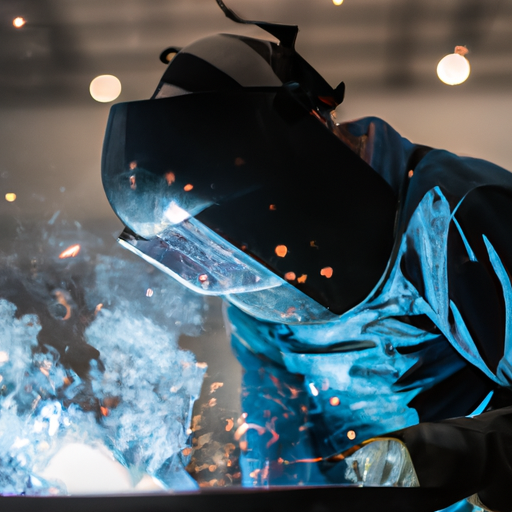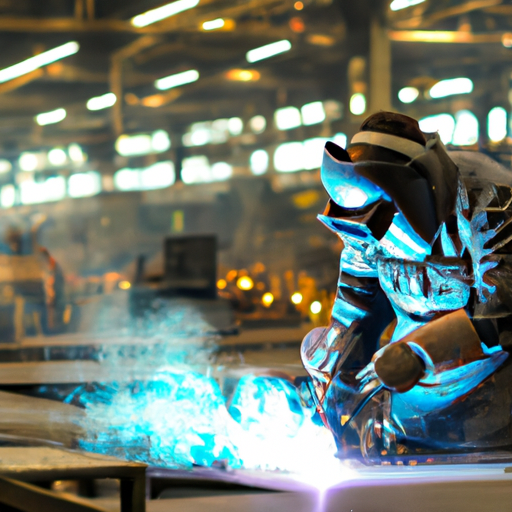Being a welder can be physically demanding, but is it really hard on the body? Many people have this question in mind as they consider pursuing a career in welding. Well, let’s put your worries to rest because in this article, we will explore the potential impact of this profession on your body. From long hours of standing to exposure to fumes and hazards, we will examine the challenges faced by welders and offer some helpful tips to maintain a healthy body while pursuing this rewarding career. So, sit back and discover the truth about being a welder and its effects on your physical well-being.

Physical Strains of Welding Jobs
Continuous standing and bending
As a welder, you spend most of your workday on your feet. The nature of the job requires you to stand for long periods of time in order to work on various projects. This can lead to fatigue and discomfort in your legs and feet. Additionally, welding often involves bending and stooping to access different angles and positions, placing strain on your back and legs.
Heavy lifting involved
Another physical challenge of welding jobs is the requirement to lift heavy objects. Whether it’s moving welding equipment or transporting materials, lifting heavy loads can take a toll on your muscles and joints. Improper lifting techniques can increase the risk of injuries, such as sprains or strains. It’s important to prioritize safety and use proper lifting techniques to minimize the strain on your body.
Dealing with intense heat
One of the defining aspects of welding is working with intense heat. The heat generated during the welding process can be extremely high, which exposes you to potential burns. The constant exposure to heat can also lead to heat-related illnesses, such as heat exhaustion or heat stroke. It’s crucial to take necessary precautions to protect yourself from excessive heat, such as wearing suitable protective clothing and taking regular breaks.
Risks of electrocution
Welding involves working with high electrical currents, posing a risk of electrocution if proper precautions are not taken. Contact with live electrical wires can be extremely dangerous and potentially fatal. As a welder, it is vital to be properly trained in electrical safety and always ensure that the equipment is in good working condition. Adhering to safety protocols and wearing appropriate protective gear can greatly reduce the risk of electrical accidents.
Long-Term Effects on the Musculoskeletal System
Impact on the spine and joints over time
The physical strains of welding jobs can have long-term effects on your musculoskeletal system. Continuous standing and bending can gradually lead to chronic pain and discomfort in the back, knees, and other joints. The repetitive nature of welding tasks puts additional stress on your spine and can contribute to the development of conditions like degenerative disc disease or herniated discs. It’s essential to maintain proper posture and take breaks to alleviate pressure on your spine and joints.
Risk of developing chronic conditions like arthritis
The repetitive motions involved in welding, combined with the constant strain on your muscles and joints, can increase the risk of developing chronic conditions like arthritis. Arthritis causes inflammation and pain in the joints, potentially limiting your mobility and overall quality of life. It’s important to prioritize self-care and engage in activities that promote joint health, such as regular exercise and maintaining a healthy weight.
The importance of proper body mechanics
To mitigate the long-term impact on your musculoskeletal system, practicing proper body mechanics while welding is crucial. This includes maintaining good posture, using ergonomically-designed equipment, and utilizing tools like adjustable work tables to minimize bending and reaching. Additionally, implementing stretching exercises and regular breaks throughout the workday can help alleviate muscular tension and reduce the risk of strain or injury.
Respiratory Health Risks
Exposure to harmful fumes and gases
During the welding process, harmful fumes and gases are released, which can pose serious respiratory health risks. These fumes contain toxic substances such as metal oxides, ozone, and nitrogen dioxide. Prolonged exposure to these substances can lead to respiratory irritation, lung damage, and even long-term respiratory illnesses.
Risk of developing respiratory diseases
Welders are at an increased risk of developing respiratory diseases, such as asthma, bronchitis, and occupational lung diseases. The inhalation of welding fumes and gases can cause inflammation and damage to the respiratory system, leading to chronic respiratory conditions. It is vital to be mindful of the environment in which you are working, ensure proper ventilation, and wear respiratory protective equipment to minimize exposure to harmful fumes.
Importance of proper ventilation and protective gear
To protect your respiratory health, it is important to work in well-ventilated areas or use exhaust systems to remove welding fumes effectively. Implementing local exhaust ventilation (LEV) systems can help capture and remove fumes at the source, preventing their inhalation. Additionally, wearing appropriate respiratory protective equipment, such as respirators or masks, can provide an extra layer of defense against harmful fumes and gases.
Eye and Skin Hazards
Risk of arc eye or ultraviolet keratitis
Welding creates intense light and radiation, including ultraviolet (UV) rays, which can severely damage the eyes if proper precautions are not taken. Arc eye, also known as welder’s flash, is a condition that occurs when the eyes are exposed to intense UV radiation. Symptoms include redness, pain, sensitivity to light, and a gritty feeling in the eyes. Long-term exposure to UV radiation without adequate eye protection can lead to permanent vision problems.
Skin burns from sparks and spatters
Welding also poses a risk to your skin. Sparks, spatters, and molten metal can cause burns and injuries if they come into contact with unprotected skin. These burns can range from minor discomfort to severe injuries that require medical attention. It is essential to wear appropriate protective clothing, such as flame-resistant gloves, jackets, and pants, to minimize the risk of skin burns.
Protection against severe radiation exposure
To protect your eyes and skin from the hazards of welding, it is crucial to wear specialized safety equipment. Welding helmets with auto-darkening filters shield your eyes from harmful UV and infrared (IR) radiation. Safety goggles or glasses with side shields provide additional protection to your eyes. Additionally, wearing flame-resistant clothing and utilizing welding curtains or screens can minimize the risk of skin exposure to sparks and spatters.

Hearing Challenges Faced by Welders
Noise-induced hearing loss
Welding processes generate high levels of noise, which can lead to noise-induced hearing loss (NIHL) over time. Continuous exposure to loud noises without proper ear protection can damage the delicate structures of the inner ear, resulting in permanent hearing loss. The severity of hearing loss depends on the duration and intensity of noise exposure.
Importance of proper ear protection
To preserve your hearing health, it is imperative to wear proper ear protection while welding. Earplugs or earmuffs specifically designed for noise reduction can help minimize the impact of loud noises on your hearing. Regularly monitoring your hearing and seeking professional evaluation can detect any early signs of hearing loss and allow for appropriate interventions.
Potential for tinnitus and other auditory problems
In addition to hearing loss, welders may be at an increased risk of developing conditions such as tinnitus, a persistent ringing or buzzing sound in the ears. Exposure to excessive noise can also cause difficulty in speech perception and communication. Protecting your hearing through the consistent use of ear protection can significantly reduce the risk of these auditory problems.
Risk of Accidents and Injuries
Potential for burns and explosions
Welding involves working with high temperatures and flammable materials, creating a risk of burns and explosions. Accidental contact with hot surfaces, sparks, or electric arcs can result in severe burns. Additionally, welding in confined spaces or near combustible materials increases the risk of explosions or fires. It is essential to adhere to safety protocols, use appropriate safety equipment, and maintain a clean and organized workspace to minimize the risk of accidents.
Risk of accidental falls
Working at heights, on ladders or scaffolding, increases the risk of accidental falls while welding. Slips, trips, and falls can cause serious injuries, including fractures, sprains, or even head trauma. Following proper fall protection measures, such as using safety harnesses or guardrails, can help prevent falls and protect your well-being.
Handling of sharp and hazardous equipment
Welding involves the use of sharp and hazardous equipment, such as welding electrodes, wire brushes, or grinders. Inattentiveness or improper handling of these tools can lead to lacerations, punctures, or other injuries. It is crucial to receive proper training on equipment handling and always use appropriate personal protective equipment (PPE) to minimize the risk of injuries.

Mental and Emotional Stress
Pressure of fulfilling job demands
Working as a welder often comes with the pressure of meeting tight project deadlines and maintaining high-quality work standards. The constant demand to deliver results can contribute to mental and emotional stress. Long hours and demanding schedules may leave little time for personal relaxation or leisure activities. It is important to manage your workload effectively and practice stress management techniques to prevent burnout.
Dangers of working in confined and potentially hazardous environments
Welding often requires working in confined spaces or hazardous environments, such as construction sites or industrial facilities. These settings can introduce additional mental and emotional stresses, as the risks associated with the job are heightened. Being aware of the potential dangers, following safety protocols, and supporting one another in maintaining a safe work environment can alleviate some of this stress.
Dealing with fatigue and sleep disruptions
Welding jobs can be physically demanding, leading to fatigue and sleep disruptions. The long hours and physically strenuous nature of the work can make it challenging to get sufficient restorative sleep. Fatigue can impair concentration, decision-making, and overall job performance, which can increase the risk of accidents. Prioritizing quality sleep, maintaining a regular sleep schedule, and practicing good sleep hygiene are essential for managing fatigue and promoting overall well-being.
Occupational Health Programs for Welders
Availability and benefits of regular health check-ups
Occupational health programs for welders can play a vital role in ensuring the well-being of individuals in this profession. Regular health check-ups and screenings can detect early signs of occupational health issues, allowing for timely interventions and management. These programs also provide an opportunity for welders to discuss any concerns or symptoms they may be experiencing and receive guidance on preventive measures.
Workplace ergonomics
Implementing proper workplace ergonomics is essential for preserving the health and well-being of welders. Ergonomically-designed workstations and equipment help minimize the strain on the body and reduce the risk of musculoskeletal disorders. This includes adjustable workbenches, supportive seating, and proper lighting to optimize work posture and reduce physical strain.
Preventive training and education programs
Welders should have access to preventive training and education programs to increase their knowledge of occupational safety and health. These programs can cover topics like proper equipment usage, hazard recognition, and safe work practices. Providing welders with up-to-date information and training empowers them to make informed decisions and actively participate in creating a safe working environment.

Adopting Safety Measures in Welding
Proper use of Personal Protective Equipment (PPE)
Personal Protective Equipment (PPE) is an integral part of ensuring the safety and well-being of welders. PPE includes items such as welding helmets, safety glasses, flame-resistant clothing, gloves, and respiratory protective equipment. It is crucial to wear and utilize the appropriate PPE for each task to effectively protect against the potential hazards associated with welding.
Emphasizing the importance of breaks and rest
Taking regular breaks and incorporating rest periods throughout the workday is essential for preventing fatigue and reducing the risk of accidents. Fatigue can impair concentration and reaction times, increasing the likelihood of mistakes or injuries. By prioritizing breaks and allowing time for rest and relaxation, welders can enhance their overall productivity and well-being.
Adopting correct lifting techniques
Heavy lifting is often a part of welding jobs, and using correct lifting techniques is crucial for minimizing the strain on your body. This includes bending at the knees, keeping the load close to your body, and utilizing the strength of your legs rather than your back when lifting. Additionally, using mechanical aids, such as cranes or forklifts, whenever possible can greatly reduce the risk of musculoskeletal injuries.
Healthy Lifestyle Choices to Counteract Strains of Welding
Balanced diet and hydration
Maintaining a balanced diet and staying properly hydrated is vital for welders to support their overall health and counteract the strains of their profession. Consuming a variety of nutritious foods, including fruits, vegetables, lean proteins, and whole grains, provides the necessary nutrients to support muscular and joint health. Staying hydrated throughout the day helps prevent dehydration and aids in the proper functioning of the body.
Regular physical exercise and physiotherapy
Engaging in regular physical exercise is essential for welders to strengthen their muscles and improve flexibility. Exercise can help counteract the physical strains of welding, reduce the risk of musculoskeletal injuries, and promote overall well-being. Additionally, seeking physiotherapy or chiropractic care can be beneficial for managing any existing musculoskeletal conditions and preventing further complications.
Managing stress through yoga and meditation
As welding jobs can be physically and mentally demanding, managing stress is crucial for maintaining overall well-being. Practicing stress-reducing activities such as yoga, meditation, or deep breathing exercises can help alleviate tension and promote relaxation. These techniques can enhance mental clarity, reduce anxiety, and support a healthy work-life balance.
In conclusion, being a welder is physically demanding and poses various challenges to your health and well-being. Continuous standing and bending, heavy lifting, exposure to intense heat, risks of electrocution, respiratory health hazards, eye and skin hazards, hearing challenges, risks of accidents and injuries, mental and emotional stress, all impact a welder’s body. However, by adopting safety measures, engaging in preventive programs, and making healthy lifestyle choices, welders can mitigate the strains associated with their job and promote their overall health and well-being.

